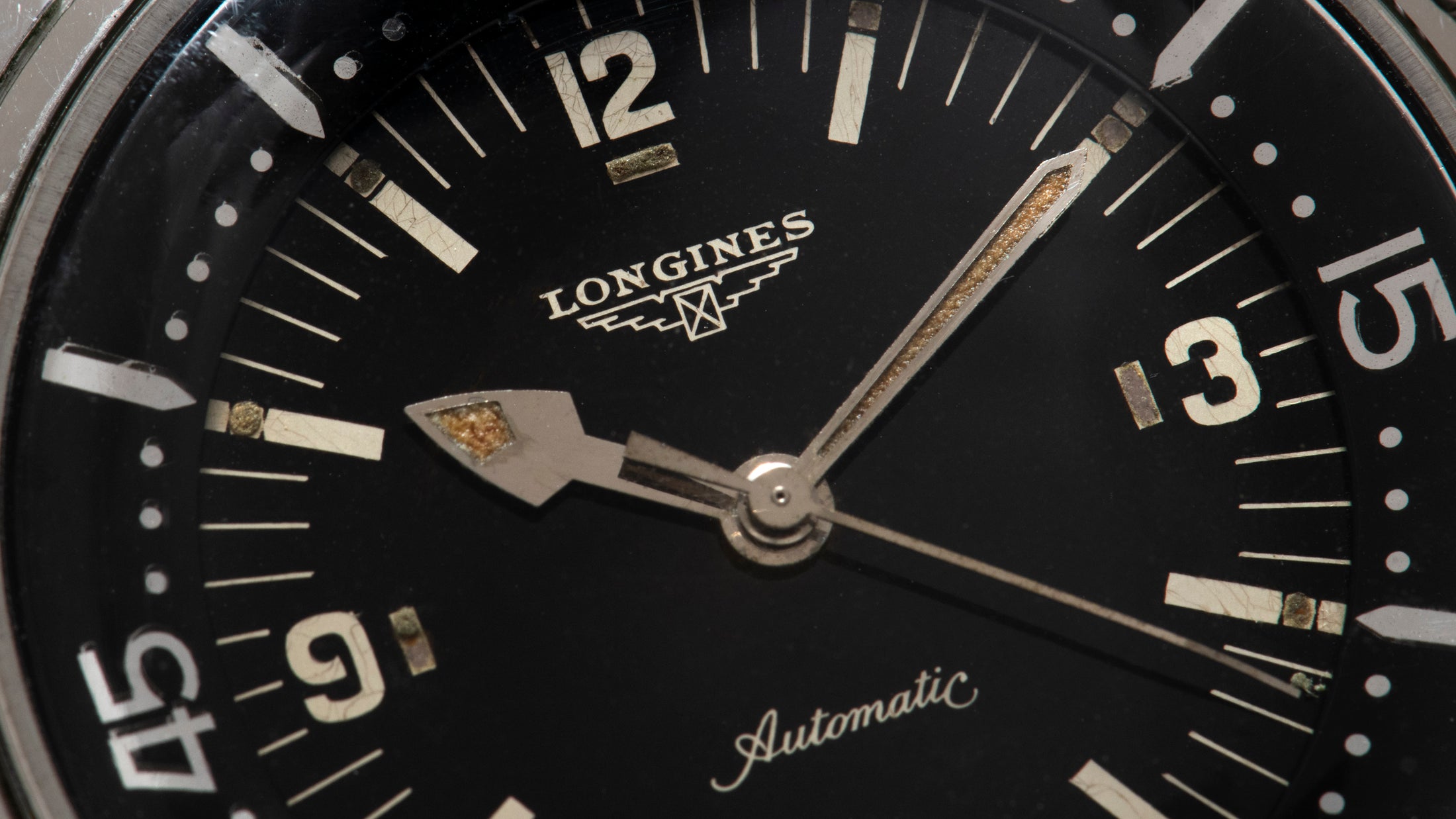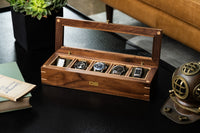If you don’t give Longines much thought these days, you’re not alone — even seasoned collectors tend not to. But this is a mistake.
A member of the Swatch Group, Longines’ contemporary wares are priced in the mid-tier — somewhat above those of sister brands Mido and Hamilton but well below premium marques such as Blancpain and Breguet.
But the company has been around a long time — since 1832, in fact. In 2019, its 51 millionth watch rolled off its assembly lines. Think about that for a moment. How did a Swiss marque, established during a time when many fellow Swiss brands constituted a single watchmaker or two toiling away in a farmhouse during the winter months, manage to take on the aspect of an American behemoth such as Hamilton or Elgin?

Auguste Aggasiz & Ernest Francilion - (Image by Longines)
Longines was founded by Auguste Aggasiz in Saint-Imier, Switzerland, along with two partners, Henri Raguel and Florian Morel. It was his nephew, however, Ernest Francilion, who in 1852, had the vision to establish a factory, thereby bringing all of the brand’s disparate suppliers under one roof. Inaugurated in 1867, this factory was located in a meadow named Les Longines.

Francilion engraved each watch that left the Longines factory with a serial number and the brand’s winged hourglass logo. - (Image by Longines)
In an impressively forward-looking move, Francilion engraved each watch that left the Longines factory with a serial number and the brand’s winged hourglass logo, which he registered in 1889 — making it the oldest such logo in continuous usage registered with the WIPO. In 1876, he sent his technical director, Jaques David, to the United States to visit the World’s Fair in Philadelphia. There, he likely saw Waltham’s exhibition of its mass-production techniques.
Upon returning home, he penned a 108-page treatise on American watchmaking — its methodology and its use of interchangeability and quality control to produce an enormous amount of timepieces very, very quickly — and presented it to Longines management. David posited that unless vast changes were made quickly, the entire Swiss watch industry would be utterly eclipsed by that of the Americans. His predictions proved prescient — indeed, it wasn’t until after the Second World War that the Swiss truly took the lead in mass production of watches.

Longines Chronograph Caliber 20H - (Image by Invaluable)
But it was enough to confirm Francilion’s hunch that a factory-based model was the way forward, and Longines continued to innovate. In 1878, the company released the Calibre 20H, an in-house chronograph movement for pocket watches. From here, it developed calibres that could measure fifths, tenths, hundreds, and even millionths of a second — all of which proved distinctly useful in sports timing. By the 1880s, its pocket watches were being used on American racetracks to time horse races.
In 1912, at the Federal Gymnastics Festival in Basel, Longines introduced an electromechanical timing system that utilized wires; when a runner broke the start or stop wire, it triggered the system, leading to extremely accurate timing. This was also the year that Longines participated in its first show jumping event. By 1924, the brand was timing skiing, and by 1939, it had introduced its first split-seconds chronograph.

Longines Chronocamera - (Image by Longines)
In 1949, the Longines Chronocaméra, an automatically-triggered photographic timing instrument capable of measuring 1/100th of a second, made its debut, and was adopted by the International Automobile Federation a year later. That same year, 1950, its electromechanical gates allowed for even more accurate race timing, and by 1971, it could directly display this timing information on television screens for the first time. By the dawn of the 1980s, Longines could individually track each competitor in Formula 1 races.
Longines’s horological milestones were themselves impressive: In 1913, it debuted its first wrist chronograph, while 1929 saw the release of the first hi-beat pocket watch movement, which ticked away at 36,000 VPH. In 1936, it released the first flyback chronograph.

A prototype, called the “Aerochronometer," developed by Weems and Longines using a repurposed duall-time pocket watch caliber from 1918, which was originally earmarked for the Turkish market. (Image by Flightbirds)
In 1927, then-Lieutenant Commander P.V.H. Weems developed the first of a series of special Longines watches for aeronautical navigation — a discipline he taught to aviation pioneers such as Charles Lindbergh and Fred Noonan. (In fact, many of the aviation records set in the early 20th century — firsts, speed records, distance records, and more — were set using Longines timing equipment.) He followed up this oversized timepiece with another in 1931, and a third in 1937.
It was during the early-to-mid 20th century that Longines developed what are still considered some of the finest time-only and chronograph calibres ever built, the 12.68z, the 13.33z, the 13ZN, and the 30CH. In the 1940s, one of its field watches joined the famed “Dirty Dozen” group of timepieces developed for the British Ministry of Defense, earning a place in horological history and the hearts of collectors everywhere. During the post-War boom of the late 1950s, Longines released its first Super Compressor-case dive watch — a model it would reissue in 2007, sparking the current state of the vintage reissue craze that has taken the watch industry by storm.

In 1983, Longines was subsumed into the organization that would become the Swatch Group — by the 1990s, it was repositioned as a mid-tier brand, and by the late 2010s, it was pumping out an utterly staggering ~1.4 million watches per year. These days, the Swiss marque has vastly increased the number of vintage-inspired reissues in its catalog, but also develops entirely new designs. For a few thousand dollars, one can buy a Longines that looks like it was made in 1950 — or one that takes on a decidedly more contemporary aspect.
Of course, for we vintage enthusiasts at Analog:Shift, there’s nothing quite as exciting as the real deal — a genuine piece from the heyday of Longines history. (Though, to be fair, the brand has had quite a long heyday!) Featured below are just a few of the company’s incredible watches, but Longines remains a value play: Though high-end, rare chronographs such as the 13ZN sell for tens of thousands, most Longines models — even drop-dead gorgeous ones from the ‘40s, ‘50s, and ‘60s — are eminently affordable compared to the competition from many other marques. Don’t believe us? Check out some of our current stock below. You’re guaranteed to be impressed!
Longines Ultra-Chron ($2,050)

Longines Ultra-Chron - IN THE SHOP
In October of 1966, Longines registered a name, Ultra-Chron, that would become significant for a then-unpredictable reason: The hi-beat movements designed to power this collection would be the last such mechanical engines equal in accuracy to that of contemporary tuning-fork watches. This particular Ultra-Chron, dating to circa 1969, incorporates one of these high-tech movements, the Calibre 431, which boasted an accuracy of two seconds per day, or a minute per month. Beautifully sized at 37mm and wonderfully thin, its handsome black dial, applied indices, and stainless steel mesh bracelet with signed Longines locking clasp make for an excellent everyday wearing experience.
Longines Steel Dress Watch ($2,150)

Longines Steel Dress Watch - IN THE SHOP
In the mid-20th century, companies such as Longines, Hamilton, and many others spit out dozens of beautiful, thin, everyday watches that found their way onto wrists around the world. These days, such timepieces make for beautiful, functional reminders of an excellent period in industrial design — one in which less was always more. This particular Longines, a Reference 7176-1, dates to the 1950s and is housed in a 35mm stainless steel case. Its silver dial has patinated to a lovely eggshell, with its original radium luminescent material changing to a deep sand color. Powered by a manually-wound Longines Calibre 30L, it’s an easy-wearing piece that’ll bring you joy every time you glance down at your wrist.
Longines 'Fancy Lug' Dress Watch ($4,450)

Longines 'Fancy Lug' Dress Watch - IN THE SHOP
One of the most remarkable features of vintage Longines dress watches are their lugs; sculpted into unique forms, they’re often fabulously creative — and affixed to watches much more affordable than similar fare from the likes of ‘Holy Trinity’ brands. This particular dress watch from the 1950s is housed in a solid yellow gold case and has several highly desirable features: In addition to its excellent 35mm width, it boasts ‘fancy’ lugs, applied ‘Breguet’ numerals, an automatic-winding movement, and an exquisite 14K yellow gold expanding multi-link bracelet with a hidden deployant clasp. You can be sure that you’ll be the only guy or gal at the party wearing anything quite like this!
Longines Greenlander 'WWW' ($5,950)

Longines Greenlander 'WWW' - IN THE SHOP
Produced at the tail end of the Second World War, the ‘Greenlander’ is one of the famed ‘Dirty Dozen’ watches made for use by the British military. It was believed for many years that Longines' entry, the Reference 23088, was used by the British North Greenland Expedition in the 1950s; while this is not the case, it does little to detract from the watch’s excellent looks and build quality. With its 38mm stainless steel case, wide bezel, black dial, and radium-filled ‘cathedral’ handset and indices, this hardy tool watch is still going strong after close to 80 years. Signed with British military markings and built like a tank, there’s little doubt that it’ll continue ticking for another 80!
Longines Lindbergh Hour Angle 90th Anniversary ($6,500)

Longines Lindbergh Hour Angle 90th Anniversary - IN THE SHOP
Following his record-setting solo flight across the Atlantic in 1927, it became clear to Charles Lindbergh that he needed to learn celestial navigation — which he did in 1928 with the help of Lieutenant Commander P.V.H. Weems of the U.S. Navy. Using what he learned, Lindbergh then developed the Hour Angle watch with Longines, which allows a pilot or navigator to calculate angular distance in the form of a time difference between a waymark and Greenwich Mean Time. Regardless of whether you plan on using this now-outdated system yourself — it was quickly bested by radio navigation, LORAN, and GPS — this reissue from 2017 is a wildly cool blast from the past.
Longines Super Compressor 'Jumbo' Diver ($8,950)

Longines Super Compressor 'Jumbo' Diver - IN THE SHOP
The “Super Compressor” case, developed by Ervin Piquirez, S.A, was a smart solution to a persistent problem — namely, that of ensuring water resistance in dive watches. In a Super Compressor case, a system of gaskets is compressed against the caseback such that the deeper the watch dives, the more water resistant it becomes. Though this brilliant design was eclipsed by increasingly better screw-down crowns, its unique aesthetic — dual crowns to control both the time-setting and the internal, rotating bezel — made for some beautiful watches, and none more so than the early, 42mm divers developed by Longines. This vintage example from the 1960s features wildly cool patina.
Longines Tre-Tacche ($11,750)

Longines Tre-Tacche - IN THE SHOP
The ‘Tre-Tacche’ and ‘Sei-Tacche’ — so-called for their three- and six-notch screw-down casebacks, respectively — are some of the best time-only watches of the 1930s, ‘40s, and ‘50s. Manually-wound, their no-frills designs often house military-style dials, though examples exist with more decorative Breguet numerals, whimsical indices, and other compelling design touches. This particular example is notable for its case size of 35mm — whereas many ‘Sei-Tacche’ measure roughly 32mm, the watch we have here is of the larger variety, which wears beautifully on any wrist. Its wide bezel and radium dial, meanwhile, look just as cool today as they did in the 1940s, when the watch was born.












